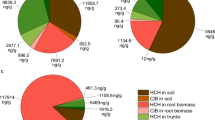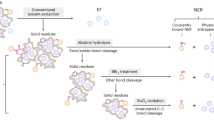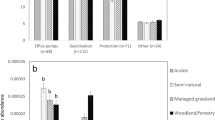Abstract
Numerous anthropogenic chemicals of environmental concern—including some phenoxy acid herbicides, organophosphorus insecticides, polychlorinated biphenyls, phthalates, freon substitutes and some DDT derivatives—are chiral. Their potential biological effects, such as toxicity, mutagenicity, carcinogenicity, and endocrine disrupter activity, are generally enantiomer-selective, and different enantiomers are preferentially degraded (transformed) by micro-organisms in various environments1,2,3,4,5,6,7,8. Here we use field and laboratory experiments to demonstrate that environmental changes in soils can alter these preferences, and to suggest that the preferences shift owing to different groups of related microbial genotypes being activated by different environmental changes. In Brazilian soils, almost all pasture samples preferentially transformed the non-herbicidal enantiomer of dichlorprop ((RS)-2-(2,4-dichlorophenoxy)propionic acid), while most forest samples either transformed the herbicidal enantiomer more readily or as rapidly as the non-herbicidal enantiomer. Organic nutrient enrichments shifted enantioselectivity for methyl dichlorprop ((RS)-methyl 2-(2,4-dichlorophenoxy)propionic acid) strongly towards preferentially removing the non-herbicidal enantiomer in soils from Brazil and North America, potentially increasing phytotoxicity of its residues relative to that of the racemate. Assessments of the risks chemical pollutants pose to public health and the environment need to take into account the chiral selectivity of microbial transformation processes and their alteration by environmental changes, especially for pesticides as up to 25 per cent are chiral9.
This is a preview of subscription content, access via your institution
Access options
Subscribe to this journal
Receive 51 print issues and online access
$199.00 per year
only $3.90 per issue
Buy this article
- Purchase on Springer Link
- Instant access to full article PDF
Prices may be subject to local taxes which are calculated during checkout


Similar content being viewed by others
References
Falconer,R. L., Bidleman,T. F., Gregor,D. J., Semkin,R. & Teixeira,C. Enantioselective breakdown of α-hexachlorocyclohexane in a small arctic lake and its watershed. Environ. Sci. Technol. 29, 1297–1302 (1995).
Jantunen,L. M. & Bidleman,T. F. Air-water gas exchange of hexachlorocyclohexanes (HCHs) and the enantiomers of α-HCH in arctic regions. Geophys. Res. 108, 28837–28846 (1996).
Aigner,E. J., Leone,A. D. & Falconer,R. I. Concentrations and enantiomeric ratios of organochlorine pesticides in soils from the U.S. corn belt. Environ. Sci. Technol. 32, 1162–1168 (1998).
Wiberg,K. et al. Enantioselective gas chromatography/mass spectrometry of methylsulfonyl PCBs with application to arctic marine mammals. Anal. Chem. 70, 3845–3852 (1998).
Garrison,A. W., Schmitt,P., Martens,D. & Kettrup,A. Enantiomeric selectivity in the environmental degradation of dichlorprop as determined by high-performance capillary electrophoresis. Environ. Sci. Technol. 30, 2449–2455 (1996).
Tett,V. A., Willetts,A. J. & Lappin-Scott,H. M. Enantioselective degradation of the herbicide mecoprop [2-(2-methyl-4-chlorophenoxy) propionic acid] by mixed and pure bacterial cultures. Microbial Ecol. 14, 191–200 (1994).
Zipper,C., Suter,M. J.-F., Haderlein,M. G. & Kohler,H.-P. E. Changes in the enantomeric ratio of (R) to (S)-mecoprop indicate in situ biodegradation of this chiral herbicide in a polluted aquifer. Environ. Sci. Technol. 32, 2070–2076 (1998).
Kohler,H.-P. E. et al. Environmental fate of chiral pollutants—the necessity of considering stereochemistry. Chimia 51, 947–95 (1997).
Williams,A. Opportunities for chiral chemicals. Pestic. Sci. 46, 3–9 (1996).
Counting on Chiral Drugs. Chem. Eng. News 76(38), 83 (1998).
Buser,H. P. & Francotte,E. in Chiral Separations (ed. Ahuja, S.) Ch. 5 (American Chemical Society, Washington DC, 1997).
Peterjohn,W. T. et al. Responses of trace gas fluxes and N availability to experimentally elevated soil temperatures. Ecol. Appl. 4, 617–625 (1994).
Lukewille,A. & Wright,R. F. Experimentally increased soil temperature causes release of nitrogen at a boreal forest catchment in southern Norway. Glob. Change Biol. 3, 13–21 (1997).
Hollibaugh,J. T. Metabolic adaptation in natural bacterial populations supplemented with amino acids. Estuar. Coast. Mar. Sci. 9, 215–230 (1979).
Akkermans,A. D. L., van Elsas,J. D. & de Bruijn,F. J. Molecular Microbial Ecology Manual 1–488 (Kluwer Academic, Dordrecht, 1995).
Fulthorpe,R. R., Rhodes,A. N. & Tiedje,J. M. High levels of endemicity of 3-chlorobenzoate-degrading soil bacteria. Appl. Environ. Microbiol. 64, 1620–1627 (1998).
Moyer,C. L., Dobbs,F. C. & Karl,D. M. Estimation of diversity and community structure through restriction fragment length polymorphism distribution analysis of bacterial 16S rRNA genes from a microbial mat at an active, hydrothermal vent system. Loihi Seamount, Hawaii. Appl. Environ. Microbiol. 60, 871–879 (1994).
Müller,M. D. & Buser,H.-R. Environmental behavior of acetamide pesticide stereoisomers. 2. Stereo- and enantioselective degradation in sewage sludge and soil. Environ. Sci. Technol. 29, 2031–2037 (1995).
Standards for the use or disposal of sewage sludge. In Code of Federal Regulations, Title 40, Part 503, Subpart B, Land Application (US Government Printing Office, revised 1 July 1998).
Lewis,D. L. EPA science: casualty of election politics. Nature 381, 731–732 (1996).
Acknowledgements
We thank R. Wright and C. Cerri for collecting soil samples, R. E. Hodson and J. T. Hollibaugh and S. Karickhoff for suggestions, and J. Avants, G. Chapman, and L. Howell for performing chiral analyses. J. Maudsley and D. Gattie assisted with bioassays. K.E.W. was supported by a National Research Council post-doctoral fellowship.
Author information
Authors and Affiliations
Corresponding author
Rights and permissions
About this article
Cite this article
Lewis, D., Garrison, A., Wommack, K. et al. Influence of environmental changes on degradation of chiral pollutants in soils. Nature 401, 898–901 (1999). https://doi.org/10.1038/44801
Received:
Accepted:
Issue Date:
DOI: https://doi.org/10.1038/44801
This article is cited by
-
Effects of Cd2+ and Pb2+ on enantioselective degradation behavior of α-cypermethrin in soils and their combined effect on activities of soil enzymes
Environmental Science and Pollution Research (2021)
-
Enantioselective Behavior of the Fungicide Tebuconazole in Soil
Environmental Processes (2020)
-
Modeling the efficiency of TiO2 photocatalytic degradation of MTBE in contaminated water: a support vector regression approach
SN Applied Sciences (2019)
-
Trace Enantioselective Determination of Imidazolinone Herbicides in Various Food Matrices Using a Modified QuEChERS Method and Ultra-Performance Liquid Chromatography/Tandem Mass Spectrometry
Food Analytical Methods (2019)
-
Enantioselective analysis and degradation of isofenphos-methyl in vegetables by liquid chromatography-tandem mass spectrometry
Environmental Science and Pollution Research (2018)
Comments
By submitting a comment you agree to abide by our Terms and Community Guidelines. If you find something abusive or that does not comply with our terms or guidelines please flag it as inappropriate.



